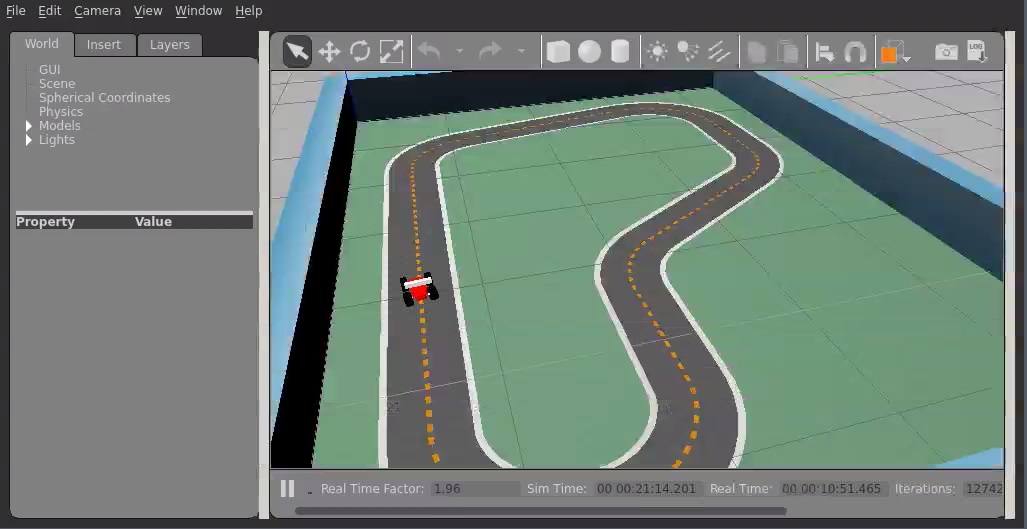This Sample Application runs a simulation which trains a reinforcement learning (RL) model to drive a car around a track.
RoboMaker sample applications include third-party software licensed under open-source licenses and is provided for demonstration purposes only. Incorporation or use of RoboMaker sample applications in connection with your production workloads or a commercial products or devices may affect your legal rights or obligations under the applicable open-source licenses. Source code information can be found here.
Keywords: Reinforcement learning, AWS, RoboMaker
- ROS Kinetic (optional) - To run the simulation locally. Other distributions of ROS may work, however they have not been tested
- Gazebo (optional) - To run the simulation locally
- An AWS S3 bucket - To store the trained reinforcement learning model
- AWS RoboMaker - To run the simulation and to deploy the trained model to the robot
You will need to create an AWS Account and configure the credentials to be able to communicate with AWS services. You may find AWS Configuration and Credential Files helpful.
You can find instructions for creating a new IAM Policy here. In the JSON tab paste the following policy document:
{
"Version": "2012-10-17",
"Statement": [
{
Action: 's3:ListBucket',
Effect: 'Allow',
Resource: [
Fn.Join('', [ 'arn:aws:s3:::', Fn.Ref(Resources.BundlesBucket) ])
]
},
{
Action: [
's3:Get*',
's3:List*'
],
Effect: 'Allow',
Resource: [
Fn.Join('', [ 'arn:aws:s3:::', Fn.Ref(Resources.BundlesBucket), '/*' ])
]
},
{
Action: 's3:Put*',
Effect: 'Allow',
Resource: [
Fn.Join('', [ 'arn:aws:s3:::', Fn.Ref(Resources.BundlesBucket), '/*' ])
]
},
{
Action: [
'logs:CreateLogGroup',
'logs:CreateLogStream',
'logs:PutLogEvents',
'logs:DescribeLogStreams'
],
Effect: 'Allow',
Resource: [
Fn.Join(':', [ 'arn:aws:logs', Refs.Region, Refs.AccountId, `log-group:${cwGroupPrefix}*` ])
]
},
{
Action: [
'ec2:CreateNetworkInterfacePermission'
],
Effect: 'Allow',
Resource: [
Fn.Join(':', [ 'arn:aws:ec2', Refs.Region, Refs.AccountId, '*' ])
]
},
{
Action: [
'ec2:AssociateRouteTable',
'ec2:CreateSubnet',
'ec2:DeleteNetworkInterface',
'ec2:DeleteSubnet',
'ec2:DescribeNetworkInterfaces',
'ec2:DescribeSecurityGroups',
'ec2:DescribeSubnets',
'ec2:DescribeVpcs'
],
Effect: 'Allow',
Resource: '*' // These ec2 commands do not support resource-level permissions
},
{
Action: [
'cloudwatch:PutMetricData'
],
Effect: 'Allow',
Resource: '*' // This command does not support resource-level permissions
},
{
Action: [
's3:DeleteObject'
],
Effect: 'Allow',
Resource: [ Fn.Join('', [ Fn.GetAtt(Resources.BundlesBucket, 'Arn'), '/', '*' ]) ]
}
]
}
cd simulation_ws
rosws update
rosdep install --from-paths src --ignore-src -r -y
colcon build
colcon bundle- MARKOV_PRESET_FILE - Defines the hyperparameters of the reinforcement learning algorithm. This should be set to
deep_racer.py. - MODEL_S3_BUCKET - The name of the S3 bucket in which you want to store the trained model.
- MODEL_S3_PREFIX - The path where you want to store the model.
- ROS_AWS_REGION - The region of the S3 bucket in which you want to store the model.
- WORLD_NAME - The track to train the model on. Can be one of easy_track, medium_track, or hard_track.
If you are running the simulation outside of RoboMaker, you will also need the following environment variables, which gives the simulation permissions to S3.
- AWS_ACCESS_KEY_ID
- AWS_SECRET_ACCESS_KEY
- AWS_SESSION_TOKEN
Once the environment variables are set, you can run local training using the roslaunch command
source simulation_ws/install/setup.sh
roslaunch object_tracker_simulation local_training.launchAs the reinforcement learning model improves, the reward function will increase. You can see the graph of this reward function at
All -> AWSRoboMakerSimulation -> Metrics with no dimensions -> Metric Name -> ObjectTrackerRewardPerEpisode
You can think of this metric as an indicator into how well your model has been trained. If the graph has plateaus, then your robot has finished learning.
You can reuse the bundle from the training phase again in the simulation phase.
The evaluation phase requires that the same environment variables be set as in the training phase. Once the environment variables are set, you can run evaluation using the roslaunch command
source simulation_ws/install/setup.sh
roslaunch object_tracker_robot evaluation.launchThe training algorithm has two phases. The first is when the reinforcement learning model attempts to navigate the robot towards its target, while the second is when the algorithm uses the information gained in the first phase to update the model. In the second phase, no new commands are sent to the TurtleBot, meaning it will appear as if it is stopped, spinning in circles, or drifting off aimlessly.
You first need to install colcon. Python 3.5 or above is required.
pip3 install colcon-ros-bundleAfter colcon is installed you need to build your robot or simulation, then you can bundle with:
# Bundling Simulation Application
cd simulation_ws
colcon bundleThis produces simulation_ws/build/output.tar.gz.
You'll need to upload this artifact to an S3 bucket. You can then use the bundle to
create a simulation application,
and create a simulation job in RoboMaker.
Most of this code is licensed under the MIT-0 no-attribution license. However, the sagemaker_rl_agent package is licensed under Apache 2. See LICENSE.txt for further information.
Create issues and pull requests against this Repository on Github

